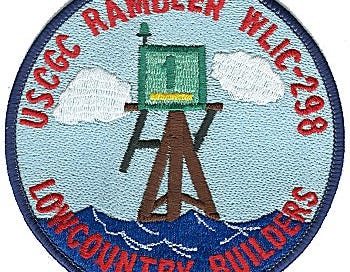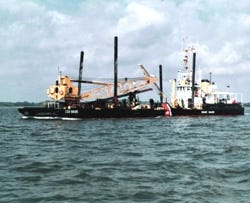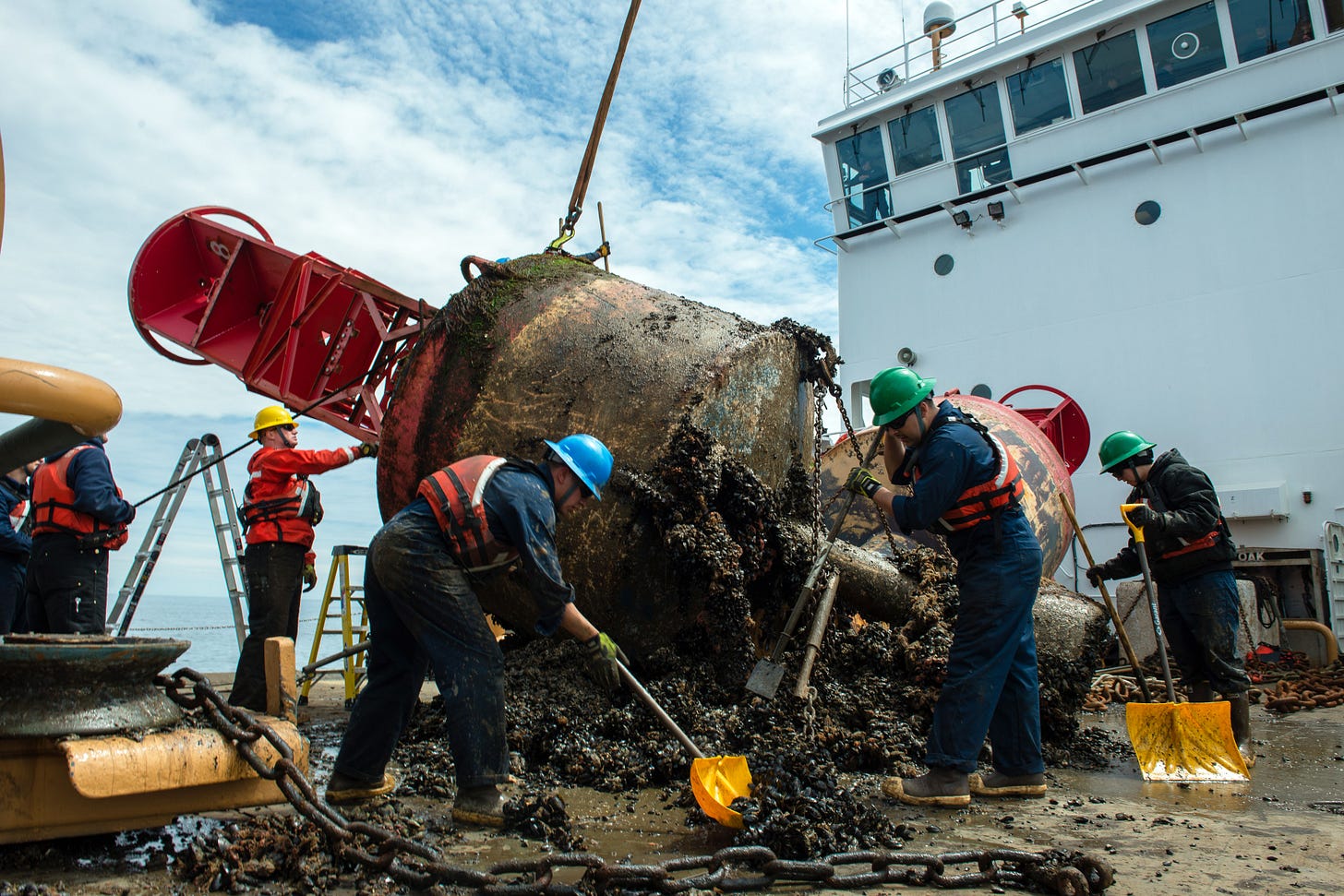Upon hearing the conversation across the deck, one our fist class boatswain’s mates added, “That sounds like a perfect match. You’d better get him down in the galley and let him get started”.
Not feeling so sure about this immediate arrangement, I politely tried to defuse any rumors or expectations of being a “gourmet”. In my best disclaimer fashion, I stated that I only know how to make a stir fry, and shrimp scampi.
He sort of smirked and said, “Stir fried foods and shrimp scampi both sound pretty darned good. That’s more of a gourmet than I’ll ever be”. I walked back to the ship’s stern, reported to the ship’s galley and living up to my new “gourmet” label, I made a batch of absolutely perfect grilled cheese sandwiches. Everyone was so impressed, but I didn’t think much of it still debunking the idea that I was ever a “gourmet”
As I mentioned in my previous post, the Rambler was a Coast Guard construction tender. To be more specific, it was a WLIC class construction tender (The “W” is the letter the US Government uses to classify US Coast Guard Ships and the “LIC” letters are an acronym that stands for Light Inland Construction). In layman’s terms, The US Coast Cutter Rambler was designed to build, service, maintain, and replace buoys and beacons along the inter coastal waterways of this country. The Rambler area of operation was the inter coastal waterways and shoreline of South Carolina. As a seaman on The Rambler, I was often assigned the task of either scraping and painting buoys, or assisting with the construction or maintenance of the various aids to navigation constructed to help boats and water going vessels navigate these waters.
If you have never serviced a Coast Guard buoy, this is basically what happens. The Rambler would gently pull up to a buoy and the crew would carefully would carefully pull it out of the water and set it on the deck. Then using garden hoes and various scrapers, all of us deckhands would begin scrape all of the kelp, seaweed (rotted and fresh), barnacles, and muck off of the buoys. Once the buoy was thoroughly scraped, we would have to paint it with a special highly reflective paint that had an olfactory sensation of very hallucinogenic airplane glue. Once all of these tasks were completed, then we would put the buoy back into the water and go to the next buoy and go through the procedure all over again.
If our crew had to work on a beacon, sign, or other navigational aids, they often were covered with an extraordinary amount of bird droppings on them. Anyone of our crew would agree that pelicans and seagulls can leave behind an extraordinary amount of both dried and fresh bird dung.
So after working a couple of weeks of scraping buoys and working on bird dung infested beacons, I began to wonder what in the world was I doing on this boat. I really was didn’t care too much for pneumatic tools, and when it came to construction, I can be pretty clumsy. I never really counted, but I dropped my=ore than my share of bolts, screws, nuts, nails, wrenches, and even a couple of hammers in the water never again to see the light of day. If there happened to be a pelican still perched on the beacon or buoy, our blood would instantly start to boil and we would take some pot shots at it with out pneumatic nail gun. We never could aim the nail gun well enough to impale a pelican with a nail, but it definitely scared them away, as they flew of just having left of fresh batch of pelican poop.
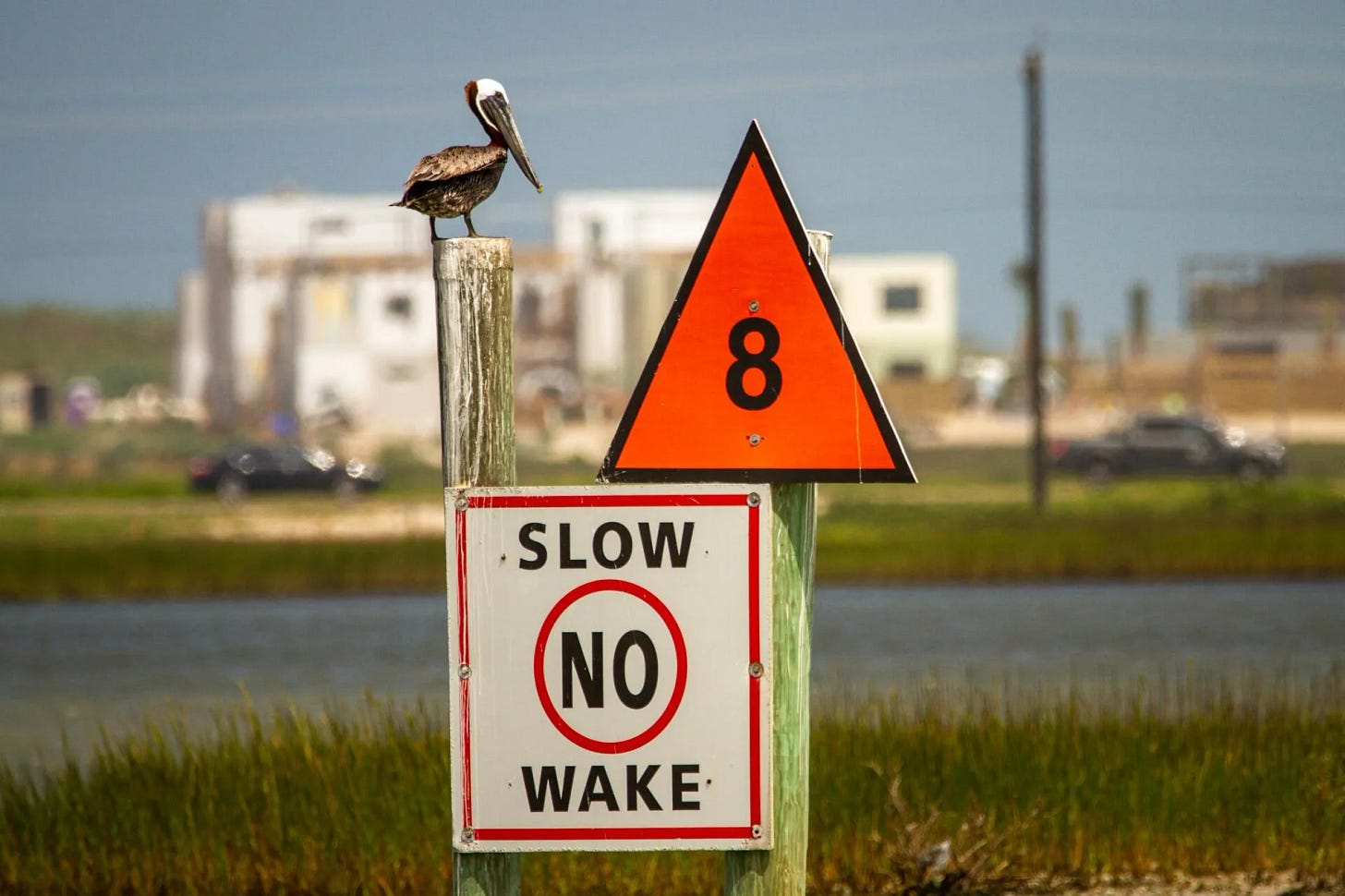
So after a couple of months scraping buoys and fixing beacons, I was beginning to wonder if there was any other work that I could do on this ship. A few days later, on really hot and humid summer day, Andy our cook would come out onto the deck, just like that first day and yelled, “I need somebody to help me cook lunch”. All of us on the deck sort of sheepishly looked at each other and then I raised my hand and volunteered for the job. Once again, I walked to the Rambler’s stern, went down into the galley and helped our cook dinner. I would help him peel the potatoes and carrots, and put together a tossed salad. After that he asked me to grill some hamburgers.
For the next few months, I would help our cook when needed as a refuge from my normal deckhand duties.Working in the galley was a far cry from having to do construction work out on the deck of the ship. The best things about working in the galley was it was air conditioned and there was a great radio in the mess deck which I took the liberty to tune to my favorite classic rock and roll station.
And so it came about that every time our cook was looking for assistance in the galley, I always made myself available for the job. I became the go to guy on the ship whenever our cook needed assistance. Whether it was grilling hamburgers or hot dogs, cutting up vegetables, making spaghetti, or peeling potatoes, or even doing the dishes, working in the galley became a regular getaway for me to get out scraping buoys out the deck.
During the spring and summer of 1988, I had been occasionally volunteering to help in the galley. In August of that year, I was presented an opportunity that would point set my life and career on its current culinary trajectory that I have yet to deviate from. Andy our cook wanted had requested and was granted a week’s leave. It was determined that our ship needed to deployed for that week to service bunch of buoys and beacons and someone really needed a cook for that week. Typically in a situation like this, our commanding officer would ask other units to find another cook to help us out for that week, but Chief Warrant Officer Paul DiMauro, my commanding officer, had taken notice of my culinary efforts and decided to ask me to be the fill in cook in Andy’s absence.
When Mr. DiMauro presented me with the opportunity, I didn’t think twice about it and immediately agreed to the proposal. As the ship’s cook, I would get out of scraping buoys for a week. In addition to that, as the ship’s cook, I also would not be required to stand any other watches, especially watches overnight. All that I had to do was to get up early enough every day to have breakfast ready, and then follow through by cooking lunch and supper.
Even though I was excited to take on the role as The Rambler’s cook for a week, I was still nervous about my new responsibilities. I had never cooked for that many people on a regular basis before, and was solely responsible for planning every meal for that week. Breakfast was pretty much the same every day, and I could make eggs, omelettes, and pancakes with no problem. But preparing lunch and dinner every day was going to be a bigger challenge. Sure I had been assisting our cook in making grilling some hot dogs or bratwursts, but now the responsibility for being the ships cook was all on my shoulders. I didn’t want to let anyone down.
I will be the first to admit that I was pretty nervous and sometimes wondered what I had gotten myself into, all in all, but my week of being our ship’s cook went really well. Not only did I successfully prepare breakfast to order every morning and fired up the ship’s grill just like before to make some great cheeseburgers, but I found a paperback copy of the Better Homes and Gardens Cookbook stashed in a drawer in the galley. Thumbing through it, I found a simple recipe for baked chicken which I mostly followed. The chicken wasn’t perfect, but it was thoroughly cooked and served with some minute rice and carrots, and it was well received by the crew.
Continuing to look through the cookbook for something that I could prepare, I found a recipe for meatloaf, which I followed exactly. Pulling that meatloaf out of the oven was one of the most satisfying moments in my life. I had successfully made meatloaf and was proud to serve it to the crew. Served with baked potatoes and a salad, this lunch was going to really stick to everyone’s ribs.
While I was proud of the meatloaf that I had prepared, I soon discovered that I had a bit of a problem though with my meatloaf. That problem was that had not prepared quite enough meatloaf to serve the whole crew (my worst fear as a cook). I had enough meatloaf for everyone except the last three guys in line. In order to feed them, I threw some bacon on the griddle, sliced some tomatoes, took some from a head of iceberg lettuce and made them a few bacon lettuce and tomato sandwiches. I apologized for not having enough meatloaf, but it was really hot that day, and none of them really had much of an appetite for a heavy lunch and that they would actually prefer having a BLT for lunch.
I finished the day by grilling some bratwursts, and was cleaning up the galley, when our commanding officer came down to the galley to get a soda and said, “You’ve been down in this galley the whole trip. When your finished, why don’t you come up to the bridge and get some fresh air.”
I really didn’t feel like it, but since he was the ship’s commanding officer, I wanted to honor his request. Coming up out of the galley , I found myself immersed in an absolutely beautiful August evening. As the sun was hanging over the horizon, there was a very gentle and warm breeze blowing. When I reached the bridge there was a spare empty chair waiting for me and the captain if our ship invited me to sit down.
“So how has your week been going down in the galley?”, he asked.
“I like just fine!”, I responded. “I did feel bad that I ran out of meatloaf today though”.
He chuckled and laughed, “Don’t worry too much about it Steve. Nobody’s starving on this ship, and I was pretty impressed that you kept your cool and quickly figured something else to make those last few guys. Those guys that had the BLTs came out of the galley bragging about how they got the better end of the deal. And all of us who had the meatloaf really enjoyed it. You’ve handled yourself really well this week and it shows.” I really appreciated his words of encouragement.
Then Mr. Dimauro asked me, “Have you yet considered what Coast Guard school you would like to attend. in a kind of shy voice I answered, “I have been thinking about it but I am not really sure what school that I want to apply to to sir”, I answered.
Then he asked me, “Have you ever considered going to SS school (“SS” is the abbreviation for Subsistence Specialist, which at the time was the official title of a certified Coast Guard cook)”. Whoever was the Coast Guard genius that decided to call a Coast Guard cook a Subsistence Specialist I really don’t know, but if I ever meet him I will definitely tell him how much I loved that name with some very explicit language. Mr. Dimauro continued, “Steve, I have been watching you this week, and I really believe that you have a great talent for cooking. The Coast Guard always needs great cooks and the SS school is in Petaluma, California. At the moment the wait time to get into the school is only about two months. I’m not telling you what to do with your life, but just give it some thought.”Quietly, I nodded my head and agreed to his request, but in my heart I knew that I was going to the Coast Guard Subsistence Specialist school in Petauluma, California.
I spent the rest of the evening on the bridge watching the sunset as our crew was finishing working on a pelican infested beacon moments before the sun went down. After my conversation with Mr. Dimauro, I felt this a comforting sense of peace and gratitude come over me. I was thankful that I was given an opportunity to be The Rambler’s cook for a week. I was especially thankful for the advice, encouragement and seeing something about myself that I was totally unaware of.
Now don’t misunderstand me. The idea of learning how to cook sparked my curiosity in a new way. I still had no desire thought that I was going to become a chef. The story of how that lightning bolt hit me will come a bit later. But the thought of going to cooking school was an incredible step to move my life forward. It was like a gate to a new world was opened and I was walking through it totally unaware of the adventure that awaited me.
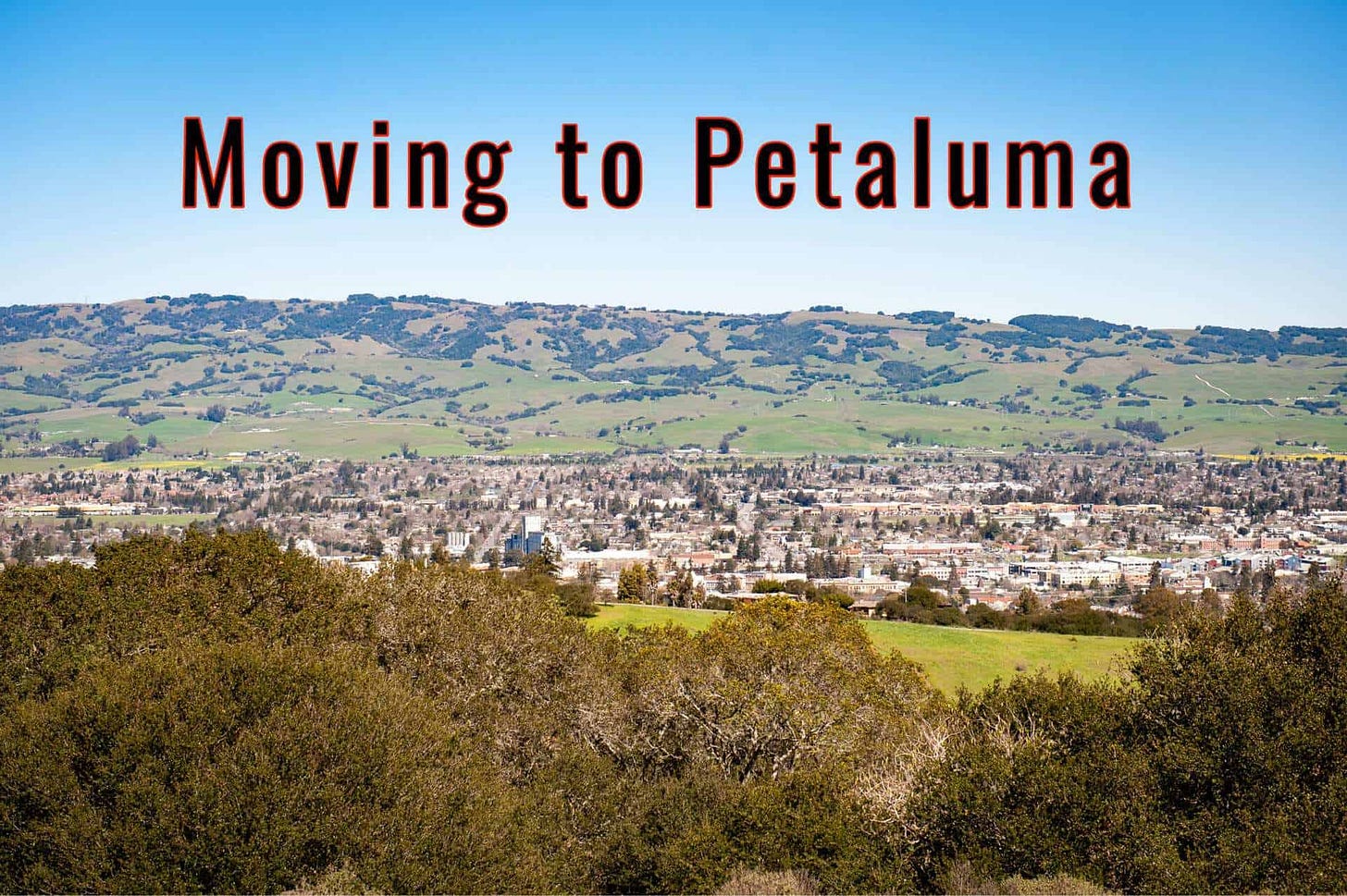
The Rambler returned to its home port in Charleston that Friday. Wanting to build upon my newfound culinary success, I told Mr. DiMauro, that I wanted start the process to request to go to Subsistence Specialist training in California. In early November of 1988, one year after I enlisted in the Coast Guard, I found myself with my sea bag packed I was leaving Charleston, South Carolina. Later that morning, I would find myself on a five hour, nonstop flight to California.

